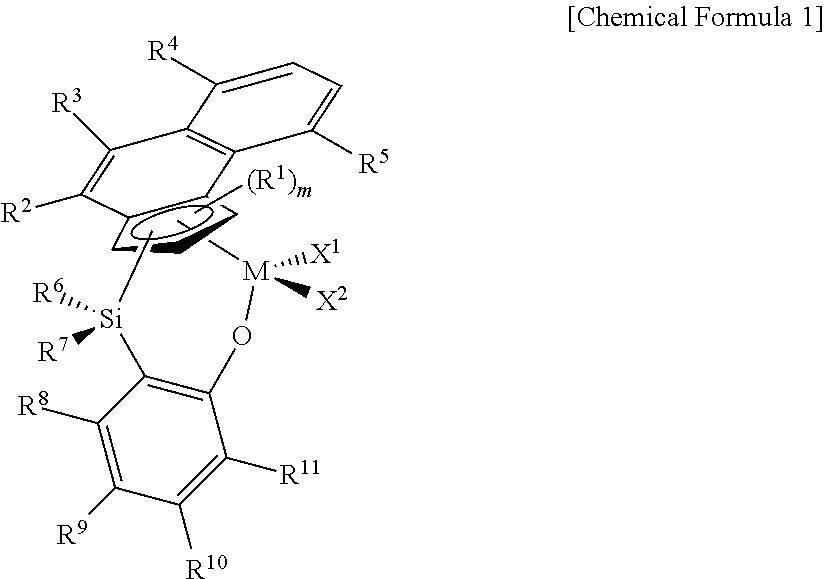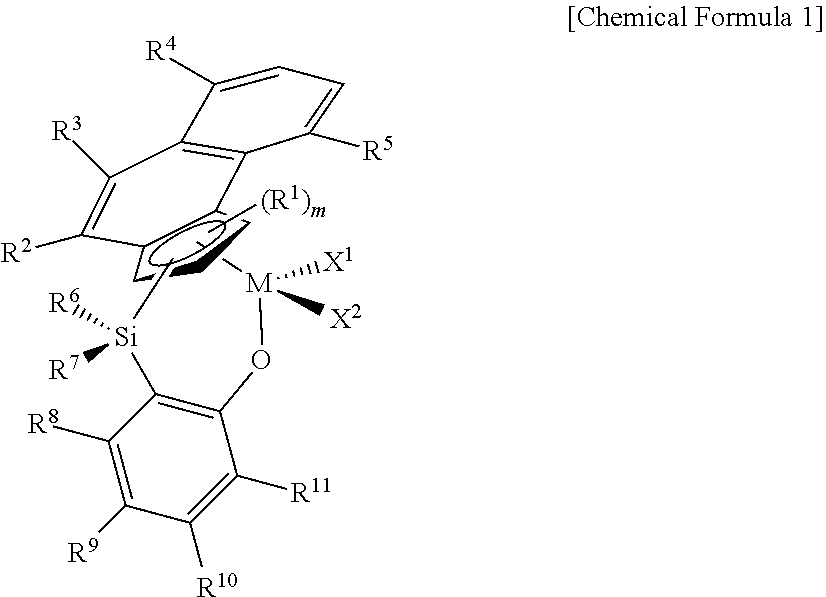Transition metal compound, catalyst composition including the same, and method for preparing ethylene homopolymer or copolymer of ethylene and α-olefin using the same
a transition metal and catalyst technology, applied in the direction of metallocenes, group 4/14 element organic compounds, chemical production, etc., can solve the problems of difficult to obtain a high molecular weight polymer in the catalyst system, broad molecular weight distribution, etc., to achieve easy preparation, simple synthesis process, and high yield
- Summary
- Abstract
- Description
- Claims
- Application Information
AI Technical Summary
Benefits of technology
Problems solved by technology
Method used
Image
Examples
example 1
Preparation of Transition Metal Catalyst 1 According to the Present Invention
[0125]
Preparation of [2-allyloxy-3-tertbutyl-5-methylphenyl](dimethyl)(2-methyl-3H-cyclopenta[a]naphthalen-3-yl) silane (Compound B)
[0126][2-(Allyloxy)-3-tert-butyl-5-methylphenyl](chloro)dimethylsilane (Compound A) was synthesized with reference to the synthesis contents described in the paper [J. Organomet. Chem., 2007, 692, 4059-4066)].
[0127]2-Methyl-9bH-cyclopenta[a]naphthalene (30.08 mmol) was added to THF (112 mL) and then a hexane solution of n-BuLi (2.5 M, 31.58 mmol) was slowly added at −78° C. After the addition of n-BuLi was completed, a temperature was slowly raised to room temperature and then the mixture was stirred for 2 hours. After the stirring was completed, the mixture was cooled to −78° C., a toluene (14 mL) solution of the [2-(allyloxy)-3-tert-butyl-5-methylphenyl](chloro)dimethylsilane (Compound A, 33.09 mmol) was slowly added dropwise, and then the temperature of the reaction mixture ...
example 2
Preparation of Transition Metal Catalyst 2 According to the Present Invention
[0133]
Preparation of [2-(allyloxy)-3-tert-butyl-5-methylphenyl](chloro)dimethylsilane (Compound D)
[0134]2-Allyloxy-1-bromo-3-tert-butyl-5-methylbenzene (19.8 g, 70 mmol) was dissolved in toluene (200 mL), then n-BuLi (36.4 ml, 2.5 M in hexane, 91 mmol) was slowly added at −78° C., and the reaction was stirred for 1 hour while raising the temperature to −20° C. The reaction mixture was cooled to −78° C. again and dichlorodiethylsilane (33 g, 210 mmol) was added rapidly. The reaction mixture was warmed to room temperature and then stirred for 5 hours. The resulting LiCl salt was filtered off and the solvent was removed in vacuo to obtain a yellow product (about 21.6 g, 95%), which proceeded without further purification for the next reaction.
[0135]1H NMR (CDCl3): δ 7.32 (m, 1H), 7.25 (m, 1H), 6.03 (m, 1H), 5.51 (m, 1H), 5.29 (m, 1H), 4.36 (m, 2H), 2.32 (s, 3H), 1.38 (s, 9H), 1.09-1.14 (m, 4H), 1.01-1.05 (m, 6H...
example 3
Preparation of Transition Metal Catalyst 3 According to the Present Invention
[0142]
Preparation of (2-allyloxy-3-tert-butyl-5-methylphenyl)(1,2-dimethylcyclopenta[a]naphthalen-3-yl)diethylsilane (Compound G)
[0143]Compound G (yield: 78%, yellow oil) was obtained in the same manner as in the preparation of Compound E of Example 2 except that 1,2-dimethyl-9bH-cyclopenta[a]naphthalene (30.08 mmol) was used instead of 2-methyl-9bH-cyclopenta[a]naphthalene (30.08 mmol).
[0144]1H NMR (CDCl3): δ 8.57 (m, 1H), 7.87 (m, 1H), 7.36-7.49 (m, 3H), 7.28 (m, 1H), 7.22 (m, 1H), 6.84 (m, 1H), 6.06 (m, 1H), 5.56 (m, 1H), 5.30 (m, 1H), 4.41 (m, 2H), 4.16 (m, 1H), 2.50 (s, 3H), 2.21 (s, 3H), 1.98 (s, 3H), 1.44 (s, 9H), 0.88-0.96 (m, 2H), 0.79-0.85 (m, 3H), 0.63-0.72 (m, 5H).
Preparation of diethylsilylene(1,2-dimethylcyclopenta[a]naphthalen-3-yl)(3-tert-butyl-5-methyl-2-phenoxy) dichlorotitanium (Compound H)
[0145]Compound H (yield: 26%, reddish-brown solid) was obtained in the same manner as in the prepara...
PUM
| Property | Measurement | Unit |
|---|---|---|
| temperature | aaaaa | aaaaa |
| pressure | aaaaa | aaaaa |
| temperature | aaaaa | aaaaa |
Abstract
Description
Claims
Application Information
 Login to View More
Login to View More - R&D
- Intellectual Property
- Life Sciences
- Materials
- Tech Scout
- Unparalleled Data Quality
- Higher Quality Content
- 60% Fewer Hallucinations
Browse by: Latest US Patents, China's latest patents, Technical Efficacy Thesaurus, Application Domain, Technology Topic, Popular Technical Reports.
© 2025 PatSnap. All rights reserved.Legal|Privacy policy|Modern Slavery Act Transparency Statement|Sitemap|About US| Contact US: help@patsnap.com



